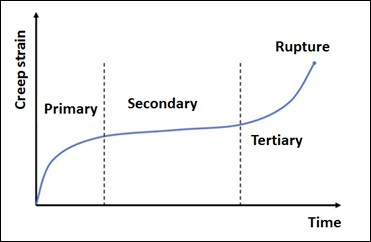Creep is a rate-dependent material nonlinearity in which the material continues to deform under a constant load. Creep occurs because of long-term exposure to a high level of stress that does not exceed the yield strength of the material. Creep is more severe in materials subjected to heat for long periods. The creep strain rate can be a function of stress, time, temperature, and neutron flux level.
Under constant load, the uniaxial strain-vs.-time creep behavior is illustrated in the following figure:
In the primary stage, which tends to occur over a comparatively short period, the strain rate decreases with time. The secondary stage exhibits an associated constant strain. In the tertiary stage, the strain rate increases rapidly until failure (rupture). Typically, the primary and secondary stages of creep are usually of greatest importance.
In static or transient structural analysis, creep can be simulated via implicit creep models. Compared to other creep methods, implicit creep is preferred as it is computationally faster and more accurate. The primary and secondary stages of creep can be simulated using different implicit creep material models, as shown in the following table:
Table 35.1: Implicit Creep Models
| Creep Equation Description | Type |
|---|---|
|
Strain Hardening |
Primary |
|
Time Hardening |
Primary |
|
Generalized Exponential |
Primary |
|
Generalized Graham |
Primary |
|
Generalized Blackburn |
Primary |
|
Modified Time Hardening |
Primary |
|
Modified Strain Hardening |
Primary |
|
Generalized Garofalo |
Secondary |
|
Exponential Form |
Secondary |
|
Norton |
Secondary |
|
Combined Time Hardening |
Both |
|
Rational Polynomial |
Both |
|
Generalized Time Hardening |
Primary |
|
User-Defined Creep |
Any |
The creep model can be selected based on available experimental data.
The temperature fluctuations endured by flip chip packages can cause progressive damage in solder joints. Damage accumulation beyond certain limits results in electrical failure. Such failures are typically the result of thermal-expansion mismatches between the materials used [1]. The mismatches lead to a complex deformation behavior, and are associated with irreversible, temperature- and strain-rate or time-dependent inelastic characteristics, producing viscoplastic deformation in and around the solder joints. Deformation behavior can be simulated via viscoplastic material models, or by a creep model used with a plasticity material model.
In the electronics industry, a primary goal of thermomechanical analysis is to simulate the stress and strain responses of the solder joint to better predict its service reliability. The problem presented here is a thermomechanical analysis of flip chip packages using creep and plasticity material models.
Because the harmful health-related effects of lead has forced electronic manufacturers to reduce their use of toxic heavy metals (including lead) in solders, thermomechanical analysis for solder joints becomes increasingly important as reliable alternative solders to replace lead-based solders are explored [2]. This example uses a lead-free solder 96.5Sn-3.5Ag.



